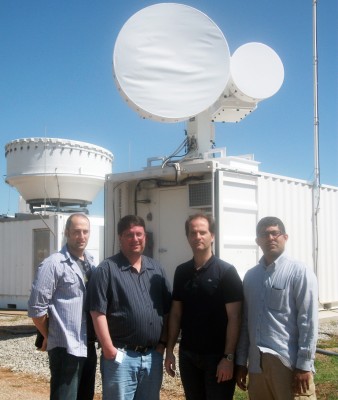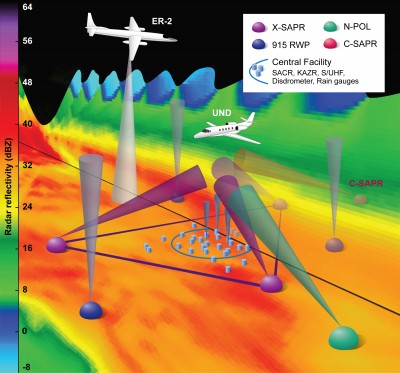We have all seen a child’s landscape drawing and its archetypal components: a yellow sun, puffy white clouds in a blue sky, and the green Earth below. Let an adult add invisible aerosols, the minute atmospheric particles that absorb or scatter sunlight, and you have climate science in a nutshell—the study of radiation, clouds, precipitation, aerosols, and all the other factors that influence planetary climate.

Convective clouds distribute water, heat, and momentum throughout the lowest layer of the Earth’s atmosphere, where weather happens. They get their name from the convective motion prompted when the surface of the Earth heats up, causing air to become buoyant and rise into the atmosphere.
With vast stores of deep moisture within these cloud systems, “they’re the ones that really drive thunderstorms and squall lines and the type of severe weather events that we’re very interested in knowing more about,” said Michael P. Jensen, an ASR-funded Brookhaven National Laboratory meteorologist. Convective clouds are also an important player in the Earth’s climate regime, he said, but one that climate models are still struggling to accurately represent and predict.
Jensen, a 20-year DOE scientist, was lead author of a paper in a Early Online Release (December 18, 2015) of the Bulletin of the American Meteorological Society (BAMS). It outlined the mission of MC3E: to improve current predictive modeling by gathering comprehensive data during a variety of weather conditions over a long interval of time.
To improve our understanding of convective clouds and the dynamic environments they create, and with storm-wracked south-central Oklahoma as an open-air laboratory, the experiment deployed an array of ground, sky, and space instrumentation in a Midwestern region of the continental United States where severe storms are seasonally common. The experiment captured data meant to characterize convective storms. Five years later, data sets from the MC3E campaign have already generated 40 scientific papers.
“There will be a long tail on this number,” said Jensen, who just compiled a bibliography of MC3E published work. “At the 10-year mark, there will still be scientists working with that data. It’s a rich data set.”
Complex Physics of Convective Clouds
The heavy influence of convective clouds on both regional weather and global climate make them important to understand. That will help ground- and satellite-based sensing instruments accurately predict, monitor, and estimate the precipitation that convective cloud systems cause over continental-scale land masses. Better understanding will also improve numerical simulations of the physics of convective clouds.
But getting accurate representations of cloud physics into weather and global climate models is still a challenge, especially regarding estimates of precipitation. “We need to understand more about them,” said Jensen of climate-affecting convective clouds, even though climate models are improving every year. “There’s a lot more to look at.”
The MC3E experiment was conducted during April and May 2011. Researchers investigated several dimensions of convective storms: their vertical structure, air motions, ice properties, and the drop size of the precipitation they create, including how that precipitation was distributed. They also tried to estimate the accuracy of space-based estimates of rainfall over land.
To get better simulations of cloud and land surfaces during storms, the researchers measured the vertical and horizontal heat and pressure structures that shape storms. To study convective cloud life cycles, they measured cloud and precipitation variability through land- and aircraft-based remote sensing. And they measured the updraft and downdraft dynamics within storm clouds, and how they related to the lower atmosphere.

Above, Within, and Below Storm Clouds
Such measurements required instrumentation on the ground, in the air, and in space. During aircraft observations and data gathering, three different vantage points were at work: a downward view by NASA’s ER-2 high-altitude aircraft, which during 73 hours in the air executed 14 flights and carried instrumentation similar to the GPM core satellite; an inside view by a University of North Dakota Cessna Citation jet, a cloud-penetrating aircraft; and a ground-based upward view of precipitation within the cloud column.
MC3E used the data-gathering capabilities of the ARM Facility’s Southern Great Plains (SGP) site. The experiment also used additional in situ radar and precipitation measurement tools.
By the end, MC3E had assembled one of the most complete data sets ever for convective cloud systems and their elusive, dynamic, and climate-critical environments. “The research,” said Jensen, “will continue.”
To learn more about the study, read these ASR research highlights: The Midlatitude Continental Convective Clouds Experiment (MC3E) or Spiraling Through a Storm.
This work was supported by the U.S. Department of Energy’s Office of Science, through the Biological and Environmental Research program as part of the Atmospheric System Research program.

